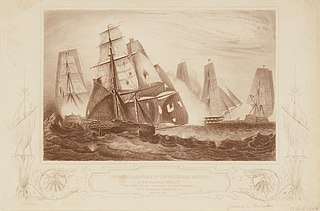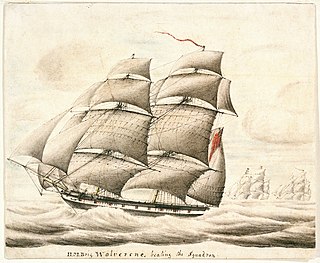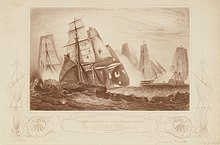
D'Hautpoul was a Téméraire class 74-gun French Navy ship of the line launched at Lorient on 2 September 1807. She was previously named Alcide and Courageux.

HMS Acasta was a 40-gun Royal Navy fifth-rate frigate. She saw service in the French Revolutionary and Napoleonic Wars, as well as the War of 1812. Although she never took part in any notable single-ship actions nor saw action in a major battle though she was at the Battle of San Domingo, she captured numerous prizes and rid the seas of many Spanish, French, and American privateers. She was finally broken up in 1821.

Bonne Citoyenne was a 20-gun corvette of the French Navy launched in 1794, the name ship of a four-vessel class. She was part of the French fleet active in the Bay of Biscay and English Channel. The Royal Navy captured her in 1796, commissioning her as the sloop-of-war HMS Bonne Citoyenne.

HMS Wolverine was a Royal Navy 18-gun Cruizer-class brig-sloop, launched in 1805 at Topsham, near Exeter. Early in her career she was involved in two fratricidal incidents, one involving a British frigate and then a newsworthy case in which she helped capture a British slave ship. She later captured a small naval vessel and several privateers, and took part in the invasion of Martinique, and during the War of 1812, in the attack on Baltimore. Wolverine was decommissioned in August or September 1815 and was sold on 15 February 1816.

HMS Forester was a Royal Navy 18-gun Cruizer-class brig-sloop built by John King and launched in 1806 at Dover. She had a relatively uneventful career before the Navy sold her in 1819.

HMS Ringdove was a Royal Navy 18-gun Cruizer-class brig-sloop that Matthew Warren built at Brightlingsea and launched in 1806. She took some prizes and participated in three actions or campaigns that qualified her crew for clasps to the Naval General Service Medal. The Admiralty sold her in 1829 to Samuel Cunard, who would go on to found the Cunard Line.

HMS Hazard was a 16-gun Royal Navy Cormorant-class ship-sloop built by Josiah & Thomas Brindley at Frindsbury, Kent, and launched in 1794. She served in the French Revolutionary Wars and throughout the Napoleonic Wars. She captured numerous prizes, and participated in a notable ship action against the French frigate Topaze, as well as in several other actions and campaigns, three of which earned her crew clasps to the Naval General Service Medal. Hazard was sold in 1817.
HMS Circe was a Royal Navy 32-gun fifth-rate frigate, built by Master Shipwright Joseph Tucker at Plymouth Dockyard, and launched in 1804. She served in the Caribbean during the Napoleonic Wars, and participated in an action and a campaign for which in 1847 in the Admiralty authorised the issuance of the Naval General Service Medal with clasps. The action, off the Pearl Rock, near Saint-Pierre, Martinique, was a debacle that cost Circe dearly. However, she also had some success in capturing privateers and a French brig. She was sold in 1814.

Diligente was a 20-gun corvette of the French Navy, lead ship of her class. Built at Brest on private plans by Pierre Ozanne, she was particularly fast. The French Navy adopted the design and copied the plans as late as 1848. Originally armed with 6-pounder guns, she was later rearmed with heavier carronades. She continued in service, off and on, until she was struck in 1854.

HMS Belette was an 18-gun Cruizer-class brig-sloop, built by King at Dover and launched on 21 March 1806. During the Napoleonic Wars she served with some success in the Baltic and the Caribbean. Belette was lost in the Kattegat in 1812 when she hit a rock off Læsø.

HMS Scorpion was a Royal Navy Cruizer-class brig-sloop built by John King at Dover and launched in 1803. She was the first of the class to be built since the launching of Cruizer in 1797. Scorpion had a long and active career during the Napoleonic Wars, earning her crews three clasps to the Naval General Service Medal when the Admiralty authorized it in 1847, two for single-ship actions. She also took a number of prizes. Scorpion was sold in 1819.

HMS Musquito. was a Royal Navy Cruizer-class brig-sloop built by John Preston at Great Yarmouth and launched in 1804. She was commissioned in October 1804 under Commander Samuel Jackson. She served in the North Sea and the Baltic, and Jackson supervised the first successful rocket attack in Europe at Boulogne in 1806. After the war she served off Africa and captured some slavers. She was broken up in 1822, having been laid up since 1818.
During the period of the French Revolutionary and Napoleonic Wars, there were two or three vessels known as His Majesty's hired armed cutter Active that served the British Royal Navy. The reason for the uncertainty in the number is that the size of the vessels raises the possibility that the first and second may have been the same vessel.

HMS Entreprenante, was a 10-gun cutter that the Royal Navy captured from the French in 1798. The British commissioned her in 1799 and she served during the French Revolutionary and Napoleonic Wars, participating in the Battle of Trafalgar. She has been the only ship of the Royal Navy to bear the name. She took part in several small engagements, capturing Spanish and French ships before she was sold in 1812 for breaking up.

HMS Childers was a brig-sloop of the British Royal Navy, initially armed with 10 carriage guns which were later increased to 14 guns. The first brig-sloop to be built for the Navy, she was ordered from a commercial builder during the early years of the American War of Independence, and went on to support operations in the English Channel and the Caribbean. Laid up for a time after the end of the American War of Independence, she returned to service shortly before the outbreak of the French Revolutionary Wars. She had an active career in both the French Revolutionary and Napoleonic Wars, capturing numerous French privateers and during the Gunboat War participated in a noteworthy single-ship action. The navy withdrew her from service at the beginning of 1811, at which time she was broken up.

HMS Skylark was a British Royal Navy 16-gun brig-sloop of the Seagull class launched in February 1806. She served primarily in the Channel, capturing several vessels including a privateer, and taking part in one notable engagement. She grounded in May 1812 and her crew burnt her to prevent the French from capturing her.

HMS Moselle was a Cruizer-class brig-sloop of the Royal Navy, launched in 1804. She served during the Napoleonic Wars in the Mediterranean, the Caribbean, and the North American station. She was sold in 1815.
HMS Renard was the French privateer Renard, launched in 1797, that Cerberus captured in the Channel that same year. The Royal Navy took her into service under her existing name and she participated in some notable engagements on the Jamaica station before the Navy sold her in 1809.
HMS Earnest was launched at Leith in 1805 as one of 48 later Archer-class gun brigs for the British Royal Navy. During her naval career Earnest captured five small privateers and numerous merchant vessels. In 1816 the Admiralty sold her and she became the merchantman Earnest. She continued to sail and was last listed in 1850.

HMS Narcissus was the lead ship of the Royal Navy Narcissus-class 32-gun fifth-rate frigates, launched in 1801. She participated in the War of 1812.














